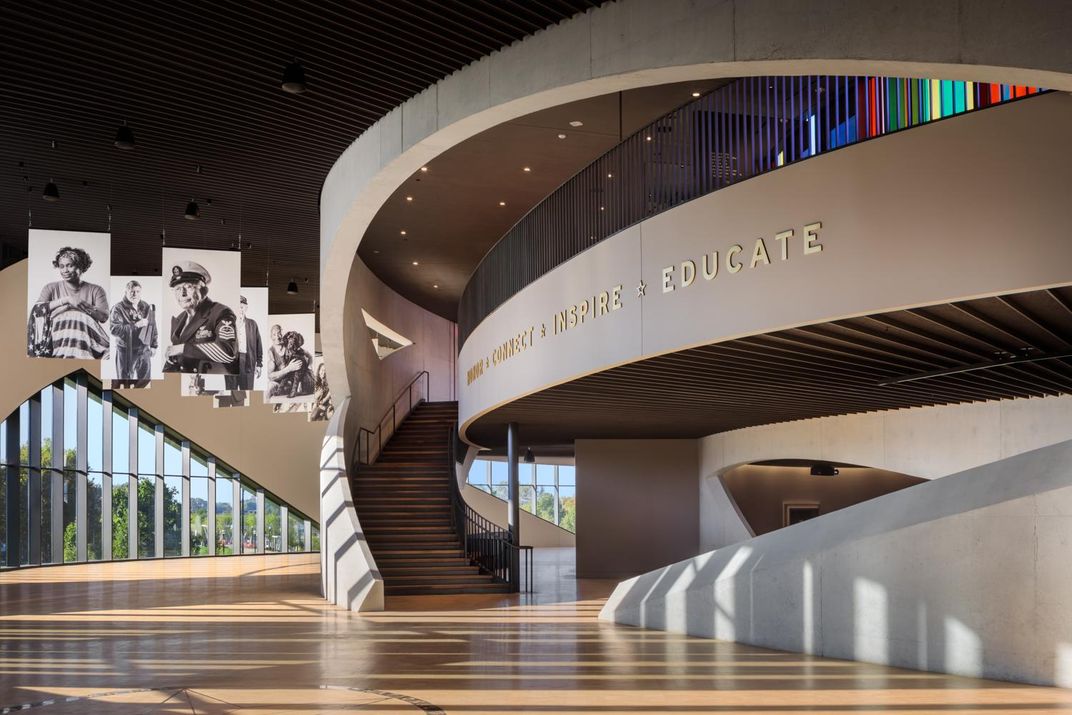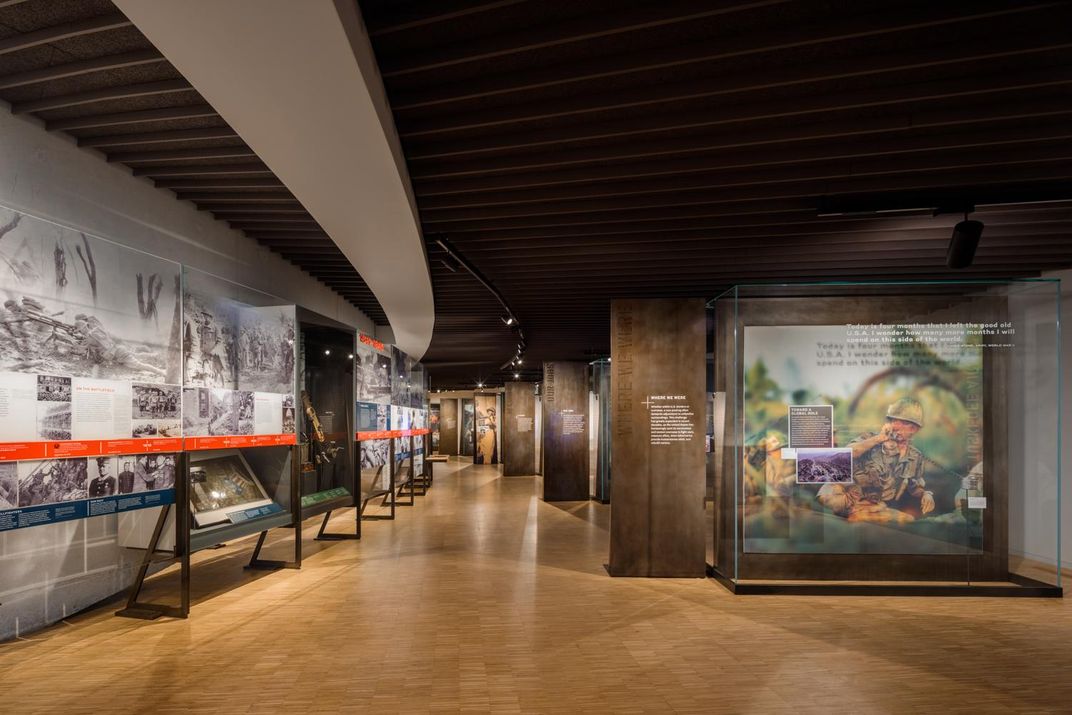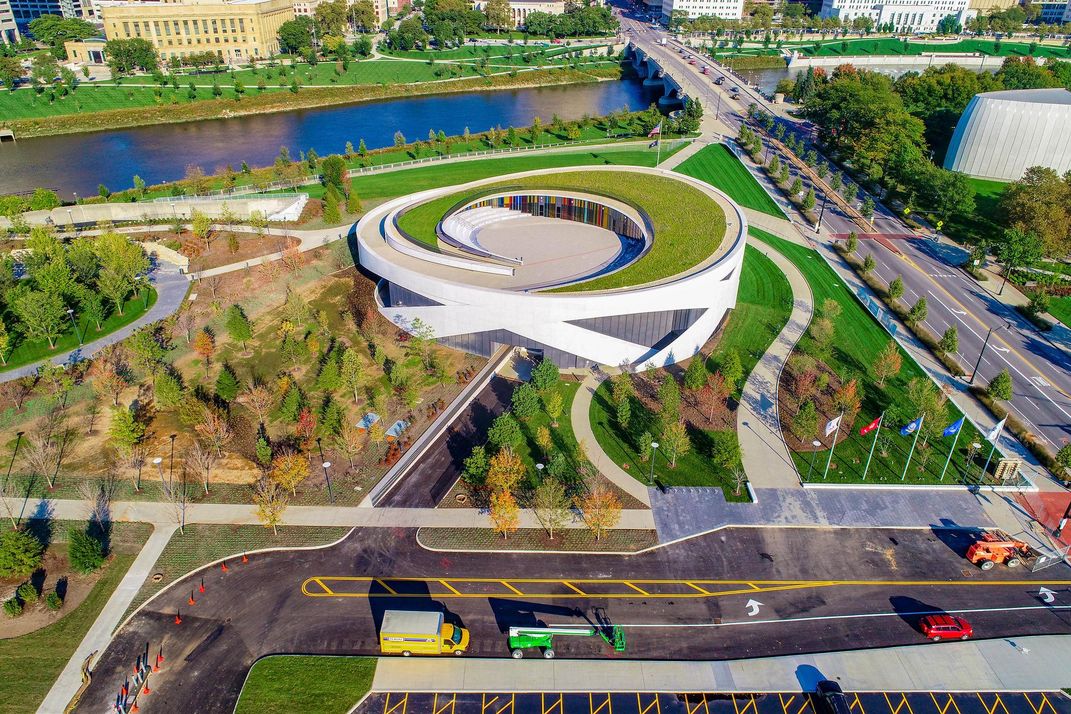A New Museum Honoring America’s Veterans Opens in Ohio
Personal stories take the place of military artifacts at the new National Veterans Memorial & Museum
/https://tf-cmsv2-smithsonianmag-media.s3.amazonaws.com/filer/f9/ca/f9caed53-16b9-4ec3-b801-d6eb5d63f2c4/dji_0135.jpg)
Whether during halftime tributes or hot-button political debates, United States military veterans can often be seen more as symbols than actual people. At a time when a shrinking proportion of the country’s population is enlisting or even has a personal connection to members of the military, the concept of military service can seem like a distant one to many—something seen in the news or pop culture rather than among one’s peers.
A new museum in Columbus, Ohio, opening today, October 27, in advance of the 100th anniversary of the end of World War I, is aiming to change that. The National Veterans Memorial & Museum (NVMM), a product of a local public/private partnership, sees itself as an institution devoted to highlighting the veterans’ voice. “We realized there is no national veterans’ museum,” says Amy Taylor, the chief operating officer of the non-profit Columbus Downtown Development Corporation. “We wanted to tell the story of all veterans and the similarities in their stories—across different times and branches, whether they served in conflict or during peacetime. We wanted to look at the journey that all veterans go through.”
Built on the Scioto River in downtown Columbus, the building’s stunning structure consists of a spiraling concrete pathway ascending to a green rooftop sanctuary, connected to a 2.5-acre grove. What sets the NVMM apart is its focus away from wars and historical events to the lives and stories of individual U.S. service members.
One of the museum’s exhibits highlights more than two dozen veterans who capture the experience of their era—sometimes in unexpected ways. For example, there’s Deborah Sampson, a Massachusetts woman who disguised herself as a man in order to serve in the Revolutionary War (even pulling musket balls from her own thighs to avoid having to see a doctor, who might discover her true sex). Or Master Sergeant Roy Benavidez, who received the Medal of Honor for saving the lives of at least eight men during the Vietnam War in a six-hour battle, in which he sustained seven gunshot wounds and shrapnel throughout his body.
“We have letters from the Revolution all the way on that had been written and sent back home, that really show the depth of their personality to their families and friends as they reflect on their experiences,” says Ralph Appelbaum, who oversaw the design of the museum’s layout. RAA has been behind exhibits at the Royal Air Force Museum and National World War I Museum, but for NVMM, Appelbaum says he and his team realized this more personal focus “could make for a very different kind of memorialization and response by honoring veterans’ living contributions.”
The museum isn’t a collecting institution—no long hallways of historic objects or an expansive displays of military artifacts—but it has these stories. Beyond the letters, the museum has hours and hours of videos of veterans sharing their memories and thoughts about their time in the military.
These films appear throughout the museum’s exhibitions, and the library of testimonials is expected to grow as veterans who visit the space record their own experiences and memories.
“We hope one day to become the clearinghouse of veteran voices,” says Samir Bitar, the museum’s director and an Army veteran himself. “You can imagine film producers or authors or podcasters in the future coming here for authentic from-the-veteran voices.”
“The stories are told in a compelling way or relatable way, but never in a sorrowful, woe-is-me way,” says Lieutenant General Michael Ferriter, who served 35 years in the Army and is now president and CEO of the NVMM. Whether touching foot lockers or listening to a veteran’s testimonial or seeing a stark picture of a funeral, visitors will “not just think but will feel,” he adds. “There will be tears shed in this museum.”
Why Columbus? In many respects, it’s because that community stepped up to meet the challenge. Since the mid-1950s, the state capital had been home to the Ohio Veterans Memorial, which was really just a convention center with a name that honored the state’s veterans. As the downtown was being redeveloped, members of the business community, led by L. Brands founder and CEO Leslie H. Wexner and his wife, Abigail, as well as city and state officials, notably Senator John Glenn, himself an Army veteran and famed astronaut, saw an opportunity to tear down the existing “memorial” and build one worthy of its name.
The NVMM puts a particular emphasis on what veterans like Glenn go on to do after their time in the military and how they continue to impact their communities and culture in other ways.
“We have a whole narrative to tell about the human who comes out of service and continues service in some other way or has a fascinating leadership role,” says Bitar, pointing to the range of veterans spotlighted in the museum, from artist Robert Rauschenberg to Edgar Allan Poe to the approximately 20 professional athletes who served in the Iraq war. “Veteran as fireman, veteran as civic leader, veteran as coach or school teacher — these stories haven’t really been told.”
Bitar added that the museum’s programming will also speak to veterans’ greater involvement in American society. He’s currently developing a lecture series and other programs that will feature veterans like Roman Baca, a choreographer and Fulbright Scholar who fought in the battle of Fallujah. Bitar expects that the offerings will surprise those who might expect a more traditional military museum experience.
“We want to hear people saying, ‘Wait, they have art there? They’re talking about science and public service and citizenship?’” says Bitar. “I don’t know if the world is going to expect that and we’re looking to change that conversation.”
“[This museum] was a chance to try and say something about the idea that many veterans express: that they want to do something meaningful back home,” says Applebaum. “That gave this project almost an optimistic view because of the journey those veterans took. Yes, it’s about honoring the veterans, but it’s also a way to connect civilians and veterans together and try to educate people about that experience.”
This is where the NVMM further distinguishes itself from other museums or memorials: its call to action. It aims to inspire visitors—veteran and non-veteran alike—to leave with a renewed desire to dedicate themselves to “something bigger than themselves” as Bitar puts it.
That call, however, only goes so far. As so many aspects of American life are viewed through the prism of politics, veterans have found themselves embroiled in controversy. From debates over funding for veterans’ services to whether kneeling football players are “disrespecting our troops,” veterans are often used as symbols — or weapons — in political battles. The museum doesn’t see itself as jumping into that fray.
Ferriter says he expects the museum would play “not a big role” in discussing political controversies of the day, but does expect that the museum’s programming will speak to veterans’ current concerns. He says of the veterans spotlighted in the museum that “those actions speak for themselves… Contemporary issues or discussions—we will likely address those at leadership symposiums. But we aren’t advocating anything other than what an awesome opportunity this is to honor our veterans.”
/https://tf-cmsv2-smithsonianmag-media.s3.amazonaws.com/accounts/headshot/Alex_Palmer_lowres.jpg)



/https://tf-cmsv2-smithsonianmag-media.s3.amazonaws.com/accounts/headshot/Alex_Palmer_lowres.jpg)